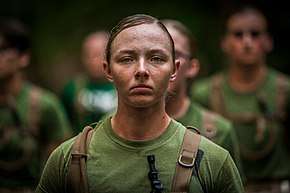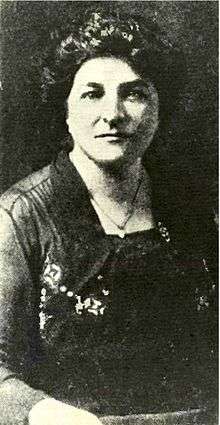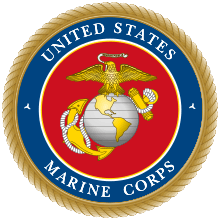Women in the United States Marines
There have been Women in the United States Marines since 1918, and women continue to serve in it today.[1][2] As of 2016, women make up 8% of all active enlisted Marines, and 7.5% of active Officers. These numbers give the Marine Corps the lowest ratio of women in all of the U.S military branches. Women's presence in the Marine Corps first emerged in 1918 when they were permitted to do administrative work in an attempt to fill the spots of male Marines fighting overseas. It wasn't until 1948 that women were able to become a permanent part of the Corps with the passing of the Women's Armed Services Integration Act. However, even with the Integration Act, women were still banned from certain military occupation specialties. It was not until 2016 that Defense Secretary Ash Carter announced that all military occupations will be open to women without exception. As of 2018, there were 92 women serving in the Marine Corps combat arms.

History

Prior to World War I
Lucy Brewer (or Eliza Bowen, or Louisa Baker) is the pen name of a writer who purported to be the first woman in the United States Marines, serving aboard the USS Constitution as a sharpshooter in the 1800s while pretending to be a man named George Baker.[5][6] Brewer's adventures were probably written by Nathaniel Hill Wright (1787–1824) or Wright's publisher, Nathaniel Coverly. No one by the name of Lucy Brewer (or that of her other pseudonyms, or that of her husband) can be found in historical records; in addition, it is highly unlikely a woman could have disguised herself for three years on the Constitution, as the crew had little to no privacy.[7] (For example, no toilet facilities or private quarters existed on the ship, and physical examinations were thorough in the Marines.) In addition, Brewer's book The Female Marine's identifying details of the Constitution's travels and battles are nearly verbatim to accounts published by the ship's commanders in contemporary newspapers.[7]
World War I
Opha May Johnson was the first known woman to enlist in the Marines. She joined the Marine Corps Reserve on August 13, 1918 during America's involvement in World War I, officially becoming the first female Marine.[1][8] From then until the end of World War I, 305 women had enlisted in the Marines.[9] They were often nicknamed "Marinettes", and helped with the office duties at the Headquarters Marine Corps, so the men who usually worked the administrative roles could be sent to France to help fight in the war.[8]
World War II
The Marine Corps created the Marine Corps Women's Reserve in 1943, during America's involvement in World War II.[10] Ruth Cheney Streeter was its first director.[11] Over 20,000 women Marines served in World War II, in over 225 different specialties, filling 85 percent of the enlisted jobs at Headquarters Marine Corps and comprising one-half to two-thirds of the permanent personnel at major Marine Corps posts.[11][12] However, it was not until after World War II, in 1948, that the Women's Armed Services Integration Act of 1948 gave women permanent status in the Regular and Reserve forces of the Marines.[10]
Korean War
The Marine Corps Women's Reserve was mobilized in August 1950 for the Korean War, eventually reaching peak strength of 2,787 active-duty women Marines.[13] Most women Marines served as part of the clerical and administrative staff.[14]
Vietnam War
In 1967 Master Sergeant Barbara Dulinsky became the first female Marine to serve in a combat zone in Vietnam.[2] At the peak of the Vietnam War, there were approximately 2,700 women Marines on active duty, serving both stateside and overseas.[15]
Middle East Conflict

One thousand women Marines were deployed for Operation Desert Storm (1990) and Operation Desert Shield (1990-1991).[15][16][17]
Female Marines served in the Afghanistan War from 2001 until 2014, and in the Iraq War from 2003 until 2011.[18][19][20][21]
Issues for Women within the Corps
Combat exclusions and women in combat (1993-present)
On April 28, 1993, combat exclusion was lifted from aviation positions by Les Aspin, permitting women to serve in almost any aviation capacity.[22]
In 1994, the Pentagon declared:
Service members are eligible to be assigned to all positions for which they are qualified, except that women shall be excluded from assignment to units below the brigade level whose primary mission is to engage in direct combat on the ground.[23]
That policy also excluded women being assigned to certain organizations based upon proximity to direct combat or "collocation" as the policy specifically referred to it.[24] According to the Army, collocation occurs when "the position or unit routinely physically locates and remains with a military unit assigned a doctrinal mission to routinely engage in direct combat."[25]
In 2013 Leon Panetta removed the military's ban on women serving in combat, overturning the 1994 rule. Panetta's decision gave the military services until January 2016 to seek special exceptions if they believed any positions must remain closed to women. The services had until May 2013 to draw up a plan for opening all units to women and until the end of 2015 to actually implement it.[26][27] In 2015 Joseph Dunford, the commandant of the Marine Corps, recommended that women be excluded from competing for certain front-line combat jobs.[28] That year a U.S. official confirmed that the Marine Corps had requested to keep some combat jobs open only to men.[29] However, in December 2015, Defense Secretary Ash Carter stated that starting in 2016 all combat jobs would open to women.[30] In March 2016, Ash Carter approved final plans from military service branches and the U.S. Special Operations Command to open all combat jobs to women, and authorized the military to begin integrating female combat soldiers "right away."[31]
Also in 2016, a female lance corporal in the Marines requested a lateral move into an infantry "military occupational specialty," making her the first female Marine to sign up for the infantry.[32]
Also in 2017, there have been many females breaking barriers in the Marine Corps. On the enlisted side, PFC Maria Daume, who was born in a Siberian prison and later adopted by Americans, became the first female Marine to join the infantry through the traditional entry-level training process.[33] On the officer side, First Lt. Marina A. Hierl became the first woman to graduate from the infantry officer course of the Marine Corps,[34][35][36] and Second Lt. Mariah Klenke became the first female officer to graduate from the Marines' Assault Amphibian Officer course.[37]
In early 2018, Col. Lorna M. Mahlock became the first African American woman to be nominated as a Brigadier general (one star) in the United States Marine Corps.[38]
Sexism and sexual harassment
Frontiero v. Richardson, 411 U.S. 677 (1973), was a landmark Supreme Court case[lower-alpha 1] which decided that benefits given by the military to the family of service members cannot be given out differently because of sex.[39]
In 1991 the Tailhook scandal occurred, in which Marine Corps (and Navy) aviators were accused of sexually assaulting 83 women (and 7 men) at the Tailhook convention in Las Vegas.[40]
In early 2017 a nude photo scandal occurred;[41][42][43] initially it was reported that the scandal was contained to only the Marine Corps, but the scandal later involved the rest of the US military.[44] The scandal caused the Corps to ensue multiple investigations on over 80 Marine personnel, as well as addressing the culture of sexual harassment within the Marine Corps.[45]
In the 2017 annual report on Sexual assault in the United States military, there were 998 reported cases of sexual assault in the Marine Corps, up 14.9% from the year before. Pentagon officials said that the increased percentage was due to the greater awareness of administrative and legal options given to victims, giving them more confidence to speak out.[46]
Sexual orientation and gender identity policy
Before the "Don't Ask Don't Tell" policy was enacted in 1993, lesbians and bisexual women (and gay men and bisexual men) were banned from serving in the military.[47] In 1993 the "Don't Ask Don't Tell" policy was enacted, which mandated that the military could not ask service members about their sexual orientation.[48][49] However, until the policy was ended in 2011 service members were still expelled from the military if they engaged in sexual conduct with a member of the same sex, stated that they were lesbian, gay, or bisexual, and/or married or attempted to marry someone of the same sex.[50]
From 1960 to June 30, 2016, there was a blanket ban on all transgender people, including but not limited to transgender women, from serving and enlisting in the United States military, including but not limited to the Marines. From June 30, 2016 to April 11, 2019, transgender personnel in the United States military were allowed to serve in their preferred gender upon completing transition. From January 1, 2018 to April 11, 2019, transgender individuals could enlist in the United States military under the condition of being stable for 18 months in their preferred or biological gender.
See also
- United States Marine Corps Women's Reserve
- Women in the military
- Sexual assault in the United States military
- Marine Corps Yumi, a manga and webcomic by Takeshi Nogami about the lives of four female Marines, based on the former Marine co-author's experiences.
Notes
- Technically, the case was decided under the Fifth Amendment's Due Process Clause, not under the Equal Protection Clause of the Fourteenth Amendment, since the latter applies not to the federal government but to the states. However, because Bolling v. Sharpe, through the doctrine of reverse incorporation, made the standards of the Equal Protection Clause applicable to the federal government, it was for practical purposes an addition not to due process, but rather to equal protection jurisprudence.
References
- Hewitt, Linda J. (1974). Women Marines In World War I (1974). United States Marine Corps History and Museums Division. Retrieved 2014-12-31.
- "Women Marines Association". Womenmarines.org. Retrieved 2015-08-11.
- Seck, Hope Hodge. "More Female, Minority Officers Join as Marine Corps Stresses Diversity". Military.com. Retrieved 2019-10-04.
- "Demographics of the U.S. Military". Council on Foreign Relations. Retrieved 2019-10-04.
- Medlicott, Alexander (December 1966). "The Legend of Lucy Brewer: An Early American Novel". The New England Quarterly. 39 (4): 461. doi:10.2307/363418. JSTOR 363418.
- Pennington, Reina (2003). Amazons to Fighter Pilots: A Biographical Dictionary of Military Women. Westport, CT: Greenwood Press. p. 70. ISBN 0313327076.
- Medlicott 1966, p. 466.
- Waxman, O.B. (August 1, 2018). "The First Woman Was Sworn Into the Marine Corps a Century Ago. Now a Group of Veterans Is Trying to Preserve Her Story". Time – via Ebscohost.
- "Women Marines". Usmcpress.com. Retrieved 2015-08-11.
- "Women In Military Service For America Memorial". Womensmemorial.org. 1950-07-27. Retrieved 2015-08-11.
- "Women in the US Military - WWII: Marine Corps Women's Reserve". Chnm.gmu.edu. Retrieved 2015-08-11.
- "Marine Corps Videos | Marine Corps Women's Reserve: 1943-1948". Marines.com. 1918-07-19. Retrieved 2015-08-11.
- Linda Cates Lacy (2004). We are Marines!: World War I to the Present. Tar Heel Chapter, NC-1, Women Marines Association. pp. 127–. ISBN 978-1-59975-887-9.
- Paul M. Edwards (1 January 2006). The Korean War. Greenwood Publishing Group. pp. 53–. ISBN 978-0-313-33248-7.
- "Women in the Marine Corps". Mcu.usmc.mil. Retrieved 2015-08-11.
- "Operation Desert Shield (1990-1991) - Honoring Our Marin Veterans". honoringmarinveterans.org.
- "6 Things to Know About Operation Desert Storm - DoDLive". www.dodlive.mil.
- Alan Taylor. "The Women of the Afghanistan War". The Atlantic. Retrieved 2015-08-11.
- Wong, Kristina (2011-12-19). "Female Marines Rebuilt Lives After Iraq Attack - ABC News". Abcnews.go.com. Retrieved 2015-08-11.
- "Afghanistan War officially ends". Militarytimes.com. 2014-12-30. Retrieved 2015-08-09.
- "Last U.S. troops leave Iraq, ending war - Reuters". Reuters. 2011-12-18. Retrieved 2014-10-29.
- Lohrenz, Carey D. (2013-01-30). "Time for Some Fearless Leadership | TIME.com". Nation.time.com. Retrieved 2015-08-09.
- New York Times - October 11, 2009
- "Department of Defense active duty military personnel by rank/grade". Department of Defense. Retrieved 2012-05-10.
- Army Regulation (27 March 1992). "Army Regulation 600-13, Army Policy For The Assignment of Female Soldiers". Department of the Army.
- "Women In Combat Ban Removed". Huffington Post. 23 January 2013.
- "Panetta to lift ban on women in combat". CBS News. 2013-06-14.
- Lolita C. Baldor. "Women not right for all combat roles, Marines say | The Columbus Dispatch". Dispatch.com. Retrieved 2015-09-20.
- Torbati, Yeganeh (2015). "U.S. military chiefs to report on opening combat roles to women". Reuters. Retrieved 2015-10-01.
- Jim Miklaszewski. "All Combat Roles Now Open to Women". NBC News.
- "Ashton Carter approves final strategy for women in military combat roles". The Washingtion Times.
- "First Female Marine Signs Up For Infantry". Scout.com. 18 April 2016.
- Babb, Carla. "Female Marine Trailblazer Graduates From Infantry School".
- "The Marines Didn't Think Women Belonged in the Infantry. She's Proving Them Wrong". The New York Times. Retrieved 2018-09-05.
- "'She's one of us': Lieutenant becomes 1st female Marine combat platoon commander". ABC News. Retrieved 2018-09-05.
- "Marines congratulate first female infantry officer graduate". TheHill. Retrieved 2017-09-26.
- Lederman, Josh. "Meet the Marines' First Female AAV Officer". Military.com. Retrieved 2017-10-04.
- "Marine Corps selects 1st black woman to be a general officer". ABC News. Retrieved 2018-09-05.
- "Frontiero v. Richardson | The Oyez Project at IIT Chicago-Kent College of Law". Oyez.org. Retrieved 2015-08-09.
- Shalal, Andrea (2012-09-10). "'Tailhook' cleaned up, but top Marine sees more work to stop sex assaults". Reuters. Retrieved 2015-08-15.
- Chappell, Bill (March 6, 2017). "Sharing Of Nude Photos Of Female Marines Online Prompts Pentagon Investigation". NPR. Retrieved March 6, 2017.
- "Nude Photo Posts of Female Marines Being Investigated by NCIS". NBC News. Washington: Associated Press. March 6, 2017. Retrieved March 10, 2017.
- Szoldra, Paul (March 9, 2017). "The Marine Corps' nude-photo-sharing scandal is even worse than first realized". Business Insider. Retrieved March 10, 2017.
- "US military nude photo sharing scandal widens beyond Marines". BBC. March 10, 2017. Retrieved March 10, 2017.
- "Marine sentenced to 10 days in "confinement" in 'Marines United' scandal". NBC News. Retrieved 2018-12-06.
- Copp, Tara (2018-04-30). "The Marine Corps had the highest increase in sexual assault reports among the services". Military Times. Retrieved 2018-12-07.
- Elizabeth Hoffman (2003-03-28). "Military Service Should Be Based On Conduct, Not Sexual Orientation". prezi.com. Retrieved January 15, 2014.
- Craig A. Rimmerman Gay rights, military wrongs: political perspectives on lesbians and gays in the military, Garland Pub., 1996 ISBN 0815325800 p. 249
- Thompson, Mark. (2008-01-28) 'Don't Ask, Don't Tell' Turns 15. TIME. Retrieved on 2010-11-30.
- Richard A. Gittins The Military Commander & the Law, DIANE Publishing, 1996 ISBN 0788172603 p. 215
External links

